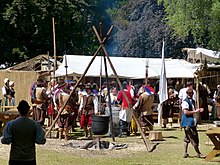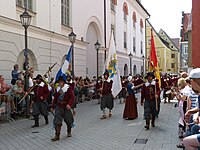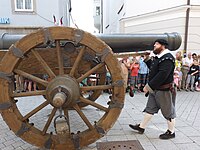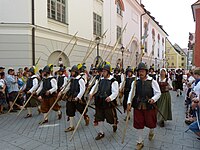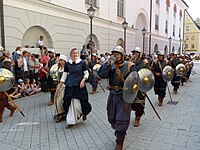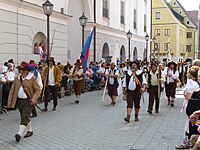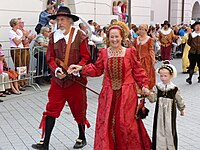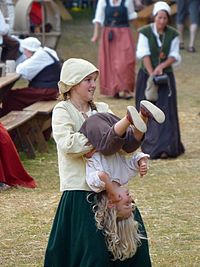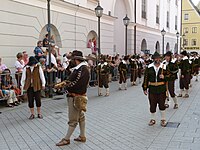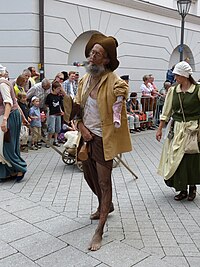Wallenstein Festival (Memmingen)
The Wallenstein Festival in Memmingen is the largest history festival in Europe and has existed since 1980. They re-enact the stay of the Commander-in-Chief of the Imperial Armed Forces of the Holy Roman Empire in the Thirty Years' War, Albrecht Wenzel Eusebius von Waldstein , known as Wallenstein , in Memmingen in 1630. They are every four years in the summer from Fischer Tags club organizes Memmingen. Due to the Corona crisis , the event planned for July 19-26, 2020 has been postponed to 2021. The festival was awarded the Bavarian Home Prize in 2018.
history
The first processing of the historical topic of Wallenstein in Memmingen in 1630 as part of a festival took place towards the end of the 19th century. A first small festival was performed on February 23, 1895 by the reading society Harmonie in the Gasthaus Falken. The festival was then included in the Great Fisherman's Day , which takes place every five years . The first Great Fisherman's Day took place in 1900 and was organized by the city council . In the same year the Fischertagsverein Memmingen e. V. was founded, which from then on was involved in the organization of the fishing day. From 1919 he was solely responsible. As part of the first Big Fisherman's Day in 1900, not only the arrival of Wallenstein in Memmingen was presented, but also the topics Welf VI. with group of crusaders and The Peasants' War . At the Great Fisherman's Day in 1905, the focus was not on Wallenstein, but on the occasion of the visit by Crown Prince Ludwig of Bavaria to Emperor Maximilian in Memmingen . The play Kaiser Maximilian in Memmingen was performed by Bernhard Hofmann. The next Big Fisherman's Day in 1925 after the First World War took up the topic of Wallenstein again, as did that of 1930. After an interruption in the Second World War , from 1950 to 1975 the Big Fisherman's Days took place in Memmingen every five years.
For the next Big Fisherman's Day in 1980, another big event was considered that would take place at regular intervals. During the vote, three major historical events emerged. In addition to Wallenstein's stay, the peasant war with the first proclamation of human rights in Europe, the so-called Twelve Articles and the Reformation , as well as the first Bavarian period in Memmingen around 1803 were discussed. Due to the greater possibilities in the representation and to avoid denominational disputes on the subject of the Reformation, it was decided to implement Wallenstein in Memmingen in 1630 . The one-week Wallenstein Festival took place in Memmingen in 1980, 1983, 1987 and every four years from 1992. The last Wallenstein Festival took place from July 24th to 31st, 2016.
Today's festivities
With around 4,500 participants and an estimated 150,000 visitors in 2016, the Wallenstein Festival is the largest history festival in Europe. The next largest historical festival in Germany is the Landshut Wedding with around 2000 participants. Due to the high level of attention to detail, both are among the most worth seeing historical festivals in Germany. The dress code is strictly detailed, the utensils, e.g. B. carts, cannons, flags, muskets and the like are reproduced. The costumes are all handcrafted by the Memminger Fischertagsverein based on old pictures and drawings.
Moving in and moving out
Wallenstein moves in and out of Memmingen on Sundays. A large parade with all participating festival groups including their carts, cannons, horses, etc., runs through the city center, starting at Ulmer Tor.
Camp life
During the entire week, the historical camp life in the Grimmelschanze and in the Reichshain Park will be recreated. Each group sets up their own warehouse here, many sell food and drinks or entertain the visitors with shows and interludes.
Camp and equestrian games
Every evening throughout the week, both the camp games in the Grimmelschanze, with performances by acrobats and fire-eaters, and the equestrian games take place in the Reichshain.
Wallenstein Theater
During the festival week, the theater group of the Fischertagsverein performs a play in Memmingen dialect against the backdrop of the Memmingen market square.
Craft market
As part of the Wallenstein Festival, the craft in Memmingen is presented at a historic craft market.
More performances
In addition, the "Tanz auf dem Kopfstein", a large dance performance in historical costumes on the cobblestones of the market square, followed by a torchlight procession, will take place during the week of the event. There is also a large battle demonstration with pyrotechnics, which usually takes place on Saturday at the Landesgartenschauge . The second Sunday of the festival begins with a historic service in St. Martin's Church .
Historical background
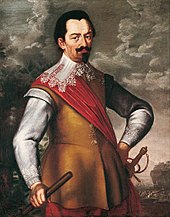
The historical background for the Wallenstein Festival in Memmingen is the stay of Albrecht Wenzel Eusebius von Waldstein in Memmingen from May 30, 1630 to October 22, 1630. As Generalissimo, Wallenstein was twice Commander-in-Chief of the Imperial Army in the Thirty Years' War between 1625 and 1634 . He fought on the side of the emperor and the Catholic League against the Protestant powers of Germany as well as against Denmark and Sweden .

He and his large court moved into their residence in the Fugger building for four months. There he received not only leading members of the military in his army, but also guests and embassies such as the papal nuncio Rocci, confidante Cardinal Richelieu , Père Joseph , and Prince Ulrich of Denmark . The latter stayed in Memmingen for 50 days, banquets and tournament games were held. In the city chronicle it says: "It was lucky and Heyl!"
During his stay in Memmingen in July 1630, Wallenstein received his dismissal in the Fuggerbau, which was decided by Emperor Ferdinand II on the Electoral Congress in Regensburg . Due to the active intervention of Gustav II Adolf of Sweden in the Thirty Years War, Wallenstein was appointed as Commander-in-Chief for the second time in 1632. In 1632 the Swedish king quartered himself in the Fugger building for a short time. Wallenstein was again declared deposed by the emperor in 1634 and murdered in Eger in Bohemia on February 25, 1634 .
Wallenstein groups
The approximately 4,500 participants are divided into different groups. Most of the groups belong to the Fischertagsverein itself, but there are also a few guest groups from all over Europe. Each group has different costumes, weapons and other props such as cannons, drums, carts, etc. The Wallenstein groups can be roughly divided into soldiers, hawsers and other groups.
soldiers
| image | group | description |
|---|---|---|
| Galla's Dragoons | The group consisted of around 140 members in 2010. The first name of the group was Tross Gallas, it was later renamed Gallas Dragoons. The group was named after Matthias Gallas . The mounted infantry was referred to as dragoons because the horses were primarily used for transport, but not for combat itself. The armament of the dragoons consists of short pikes and the matchlock rifle. | |
| Gunners | The group of gunners was founded before the first Wallenstein Festival in 1972 as a historic fishermen's day group. At the first Wallenstein Festival in 1980, the group was renamed the Imperial Artillery of Count Johann Philipp von Breuner. Since 1987 the gunners have owned the largest replica of a cannon from the Thirty Years War, the "Nightingale". At the 2008 Wallenstein Festival, the group consisted of around 70 members. | |
| Wallenstein's bodyguard | Wallenstein's bodyguard was founded on the occasion of the first Wallenstein Festival in 1980. The group size in 2010 was around 110 members. | |
| Bodyguard Danes | The Danes' bodyguard refers to the two presence of Ulrich III. (* 1611; † 1633), a son of Christian IV. King of Denmark and Norway and Duke of Holstein in Memmingen. In 2010 the group had 75 members. | |
| Musketeers | The musketeers who belong to the infantry derive their name from the weapon used, the musket . The musket is a muzzle-loading rifle and shoots lead or stone balls. The musketeers were used from the 16th to the early 19th centuries. The group of musketeers was founded in 1979. In 2010 it had over 190 members. | |
| Pikemen | The pikemen belonged to the heavy infantry from the 15th to the 17th centuries. The name of the group is derived from the main weapon, the pike. At the Wallenstein Festival, the pikemen make up the largest group with over 400 members. | |
| Rontartschiere | The Rontartschiere group was only founded in 2006 and in 2010 consisted of almost 60 members. The name of the group is derived from the Rondartsche , the round shield used. The Rontartschiere are armed with long swords, as armor they wear a breastplate and a helmet. | |
| Waldenfels War Chest | The Waldenfels War Chest group, consisting of around 60 members, is responsible for guarding and securing the war chest. The war chest is transported on a cash cart over five meters long. | |
| Kürisser "Pappenheimer" | The Kürisser represent the riders under Gottfried Heinrichs von Pappenheim (1594–1632) who fought under Wallenstein's command. At the Battle of Lützen , Wallenstein sent a request for help to Gottfried Heinrich von Pappenheim, to which the latter reacted and fell in the battle. During the parades and the equestrian games, the Kürisser appear in full armor with armored gloves, a storm helmet with a visor, and plumes and sashes. A field blacksmith accompanies the cuirassers. | |
| Magyars | The cavalry people of the Magyars originally came from Hungary and were defeated in 955 at the battle of the Lechfeld . In the 17th century the Magyars served under the imperial general Johann Ludwig Hector von Isolani (1586–1640) in the Thirty Years' War. Isolani fought under Wallenstein, but then fell away from Wallenstein in 1634. The Magyars have been part of the Wallenstein Festival since 1987 as an independent group. |
hawser
| image | group | description |
|---|---|---|
| Truss Aldringen | In the course of the first Wallenstein Festival in 1980, the train was founded under the name Soldatentross I. During the 1987 Festival, the entourage was given the nickname Aldringen. It was named after Johann von Aldringen (1588–1634), an imperial general who was involved in the plot to remove and murder Wallenstein. In 2010 the entourage had around 60 members. | |
| Bunch of butlers | The group was named after the Irish Colonel Walter Butler (around 1600–1634). Walter Butler was instrumental in the murder of Wallenstein in 1634. The group had around 100 participants in 2010. The entourage consists of the members, a sutler's wagon and a prisoner. | |
| Tross Piccolomini | The name of the group refers to Octavio Piccolomini (1599–1656). Piccolomini served as general under Wallenstein. He later led the plot against Wallenstein. In 2010 the entourage consisted of around 130 members. It only exists during the Wallenstein Festival and consists of the Landsknechte fishermen's group. | |
| Tross Schaffgotsches | The name of the baggage train refers to Hans Ulrich von Schaffgotsch (1595–1635), an imperial general who fought in the wake of Wallenstein. Simultaneously with the deposition and murder of Wallenstein, Schaffgotsch fell out of favor and was executed in 1635. In 2010 the entourage had around 65 members. |
Other groups
| image | group | description |
|---|---|---|
| Nobility , court | In the wake of the trains from Wallenstein, the nobility assembled internationally. Representatives of the Italian noble families Collalto and Piccolomini as well as representatives of the Spanish and Danish nobility accompanied the train. Mostly these were the parents, wives or children of the military leaders. | |
| Servants | The servants were responsible for the catering of Generalissimo Wallenstein and his guests. The maintenance of the premises was also part of their area of responsibility. | |
| beggar | In 2010 the group of beggars consisted of over 40 members. The beggars were omnipresent in Memmingen during the Thirty Years' War, as in many other cities. The proceeds from begging during the Wallenstein Festival serve a charitable purpose. | |
| population | The group of the population was founded in 1983. However, such a group was formed during the first Wallenstein Festival, mostly from members of the Memmingen traditional costume association. In 2010 the group had around 300 members. It has its camp on the Grimmelschanze and leads there u. a. a puppet theater. | |
| Bag cutter | In 2010 the group of bag cutters had around 110 members. The name bag cutter refers to a thief who cut the purse and its contents from the belt. At the Wallenstein Festival, the bag cutters are recognizable by their clothing and sell the tickets. The group's camp is located in Grimmelschanze. | |
| Juggler | The group of jugglers was founded in 1980; she was largely recruited from the gymnastics department of TV Memmingen. In 2010 the group consisted of around 30 members. The task of the jugglers is to entertain the entire entourage. The jugglers appear as part of the camp games. | |
| Theater group | Theatrical performances have also taken place during the Wallenstein Festival since 1980. These are held outdoors on the market square. In 2010 the theater group had around 150 members. | |
| Urban | The group of the municipal or the councils, secret, church elders had almost 80 members in 2010. The urban embody the imperial citizens of the free imperial city of Memmingen. | |
| Merchants | The reason why the merchants joined Wallenstein's army was to protect them from robbers and raids that the army offered. In 2010 the group consisted of around 80 people. The group leads u. a. a merchant and salt wagon with them. | |
| Traveling people | The traveling people group was founded in 1992 and in 2010 consisted of around 75 members. The traveling people accompanied the army and provided entertainment for the soldiers. | |
| Jagdgruppe Jäger Holk | The group was founded at the first Wallenstein Festival in 1980. The hunting group accompanying the Wallenstein entourage carried out the hunt traditionally with falcons, among other things. The name of the group refers to Heinrich von Holk (* 1599, † 1633), a general under Wallenstein. | |
| Sutlery | The name Sutlery is derived from the Italian mercatante or mercadante, a subsidiary form of mercante (trader). The job of the sutlers was to supply the entourage with food. They accompanied the hawser from the late Middle Ages to the early modern period . The group already existed at the first Wallenstein Festival in 1980 and in 2010 consisted of around 70 people. | |
| Marauders | The marauders were recruited from wounded, deserters, or otherwise unfit soldiers. The name Marodeur is derived from the French maraude or maraudage , which means "field theft". In 2010 the group consisted of around 65 members. |
Web links
literature
- Fischertagsverein Memmingen eV (Ed.): 30 years of Wallenstein - The citizens of the city of Memmingen play their story - 1980–2010 . Memminger MedienCentrum, Memmingen 2010, ISBN 978-3-927003-55-2 .
Individual evidence
- ↑ Söder awards “Heimatpreis Schwaben” | Bavarian state portal. Retrieved June 22, 2019 .
- ↑ Fischertagsverein Memmingen e. V. (Ed.): 30 years of Wallenstein - The citizens of the city of Memmingen play their story - 1980–2010. Memminger MedienCentrum, Memmingen 2010, page 10
- ↑ Fisherman's Day Association. Retrieved August 16, 2012 .
- ↑ Fischertagsverein Memmingen eV (Ed.): 30 years of Wallenstein - The citizens of the city of Memmingen play their story - 1980–2010. Memminger MedienCentrum, Memmingen 2010, pages 11–13
- ↑ Fischertagsverein Memmingen e. V. (Ed.): 30 years of Wallenstein - The citizens of the city of Memmingen play their story - 1980–2010. Memminger MedienCentrum, Memmingen 2010, pages 8, 9
- ↑ Memminger Zeitung, July 1, 2008, page 6 (supplement)
- ↑ Welt.de - "The general is moving in this year with the carriage"
- ↑ Wallenstein is attracting the masses again . In: Allgäuer Zeitung . Allgäuer Zeitungsverlag GmbH, Memmingen August 1, 2016 ( wallenstein-mm.de [PDF]).
- ↑ Fischertagsverein Memmingen eV (Ed.): 30 years of Wallenstein - The citizens of the city of Memmingen play their story - 1980–2010. Memminger MedienCentrum, Memmingen 2010, page 9
- ↑ Golo Mann : Wallenstein. His Life , Frankfurt am Main 2016 (first 1971), pp. 668–672
- ↑ Fischertagsverein Memmingen eV (Ed.): 30 years of Wallenstein - The citizens of the city of Memmingen play their story - 1980–2010. Memminger MedienCentrum, Memmingen 2010, page 88
- ^ Website of the Gallas Dragoons. (No longer available online.) Archived from the original on March 31, 2012 ; Retrieved August 6, 2012 . Info: The archive link was inserted automatically and has not yet been checked. Please check the original and archive link according to the instructions and then remove this notice.
- ↑ Fischertagsverein Memmingen e. V. (Ed.): 30 years of Wallenstein - The citizens of the city of Memmingen play their story - 1980–2010. Memminger MedienCentrum, Memmingen 2010, page 90
- ↑ Internet presence of the gunners. Retrieved August 6, 2012 .
- ↑ Fischertagsverein Memmingen e. V. (Ed.): 30 years of Wallenstein - The citizens of the city of Memmingen play their story - 1980–2010. Memminger MedienCentrum, Memmingen 2010, page 66
- ↑ Website of the Wallenstein bodyguard. (No longer available online.) Archived from the original on June 3, 2013 ; Retrieved August 6, 2012 . Info: The archive link was inserted automatically and has not yet been checked. Please check the original and archive link according to the instructions and then remove this notice.
- ↑ Fischertagsverein Memmingen eV (Ed.): 30 years of Wallenstein - The citizens of the city of Memmingen play their story - 1980–2010. Memminger MedienCentrum, Memmingen 2010, page 72
- ^ Website of the bodyguard Danes. Retrieved August 6, 2012 .
- ↑ Fischertagsverein Memmingen eV (Ed.): 30 years of Wallenstein - The citizens of the city of Memmingen play their story - 1980–2010. Memminger MedienCentrum, Memmingen 2010, page 52
- ↑ The Musketeers' website. Retrieved August 6, 2012 .
- ↑ Fischertagsverein Memmingen eV (Ed.): 30 years of Wallenstein - The citizens of the city of Memmingen play their story - 1980–2010. Memminger MedienCentrum, Memmingen 2010, page 60
- ↑ The pikemen's website. Retrieved August 6, 2012 .
- ↑ Fischertagsverein Memmingen eV (Ed.): 30 years of Wallenstein - The citizens of the city of Memmingen play their story - 1980–2010. Memminger MedienCentrum, Memmingen 2010, page 58
- ↑ The Rontartschiere website. Retrieved August 6, 2012 .
- ↑ Fischertagsverein Memmingen eV (Ed.): 30 years of Wallenstein - The citizens of the city of Memmingen play their story - 1980–2010. Memminger MedienCentrum, Memmingen 2010, page 56
- ↑ Internet presence of the Waldenfels War Chest. (No longer available online.) Archived from the original on August 28, 2010 ; Retrieved August 6, 2012 . Info: The archive link was inserted automatically and has not yet been checked. Please check the original and archive link according to the instructions and then remove this notice.
- ↑ Fischertagsverein Memmingen eV (Ed.): 30 years of Wallenstein - The citizens of the city of Memmingen play their story - 1980–2010. Memminger MedienCentrum, Memmingen 2010, page 48
- ↑ Fischertagsverein Memmingen eV (Ed.): 30 years of Wallenstein - The citizens of the city of Memmingen play their story - 1980–2010. Memminger MedienCentrum, Memmingen 2010, page 80
- ↑ Fischertagsverein Memmingen eV (Ed.): 30 years of Wallenstein - The citizens of the city of Memmingen play their story - 1980–2010. Memminger MedienCentrum, Memmingen 2010, page 50
- ↑ Internet presence of the Tross Aldringen. Retrieved August 6, 2012 .
- ↑ Fischertagsverein Memmingen e. V. (Ed.): 30 years of Wallenstein - The citizens of the city of Memmingen play their story - 1980–2010. Memminger MedienCentrum, Memmingen 2010, page 86
- ↑ Fischertagsverein Memmingen eV (Ed.): 30 years of Wallenstein - The citizens of the city of Memmingen play their story - 1980–2010. Memminger MedienCentrum, Memmingen 2010, page 74
- ↑ Fischertagsverein Memmingen e. V. (Ed.): 30 years of Wallenstein - The citizens of the city of Memmingen play their story - 1980–2010. Memminger MedienCentrum, Memmingen 2010, page 64
- ↑ Fischertagsverein Memmingen eV (Ed.): 30 years of Wallenstein - The citizens of the city of Memmingen play their story - 1980–2010. Memminger MedienCentrum, Memmingen 2010, page 68
- ↑ Fischertagsverein Memmingen eV (Ed.): 30 years of Wallenstein - The citizens of the city of Memmingen play their story - 1980–2010. Memminger MedienCentrum, Memmingen 2010, page 68
- ↑ Fischertagsverein Memmingen eV (Ed.): 30 years of Wallenstein - The citizens of the city of Memmingen play their story - 1980–2010. Memminger MedienCentrum, Memmingen 2010, page 100
- ↑ Fischertagsverein Memmingen eV (Ed.): 30 years of Wallenstein - The citizens of the city of Memmingen play their story - 1980–2010. Memminger MedienCentrum, Memmingen 2010, page 96
- ↑ Fischertagsverein Memmingen e. V. (Ed.): 30 years of Wallenstein - The citizens of the city of Memmingen play their story - 1980–2010. Memminger MedienCentrum, Memmingen 2010, page 46
- ↑ Fischertagsverein Memmingen e. V. (Ed.): 30 years of Wallenstein - The citizens of the city of Memmingen play their story - 1980–2010. Memminger MedienCentrum, Memmingen 2010, pages 122–129
- ↑ Fischertagsverein Memmingen eV (Ed.): 30 years of Wallenstein - The citizens of the city of Memmingen play their story - 1980–2010. Memminger MedienCentrum, Memmingen 2010, page 104
- ↑ Fischertagsverein Memmingen eV (Ed.): 30 years of Wallenstein - The citizens of the city of Memmingen play their story - 1980–2010. Memminger MedienCentrum, Memmingen 2010, page 94
- ↑ Fischertagsverein Memmingen eV (Ed.): 30 years of Wallenstein - The citizens of the city of Memmingen play their story - 1980–2010. Memminger MedienCentrum, Memmingen 2010, page 98
- ↑ Fischertagsverein Memmingen eV (Ed.): 30 years of Wallenstein - The citizens of the city of Memmingen play their story - 1980–2010. Memminger MedienCentrum, Memmingen 2010, page 76
- ↑ Fischertagsverein Memmingen e. V. (Ed.): 30 years of Wallenstein - The citizens of the city of Memmingen play their story - 1980–2010. Memminger MedienCentrum, Memmingen 2010, page 78
- ↑ Fischertagsverein Memmingen eV (Ed.): 30 years of Wallenstein - The citizens of the city of Memmingen play their story - 1980–2010. Memminger MedienCentrum, Memmingen 2010, page 102



